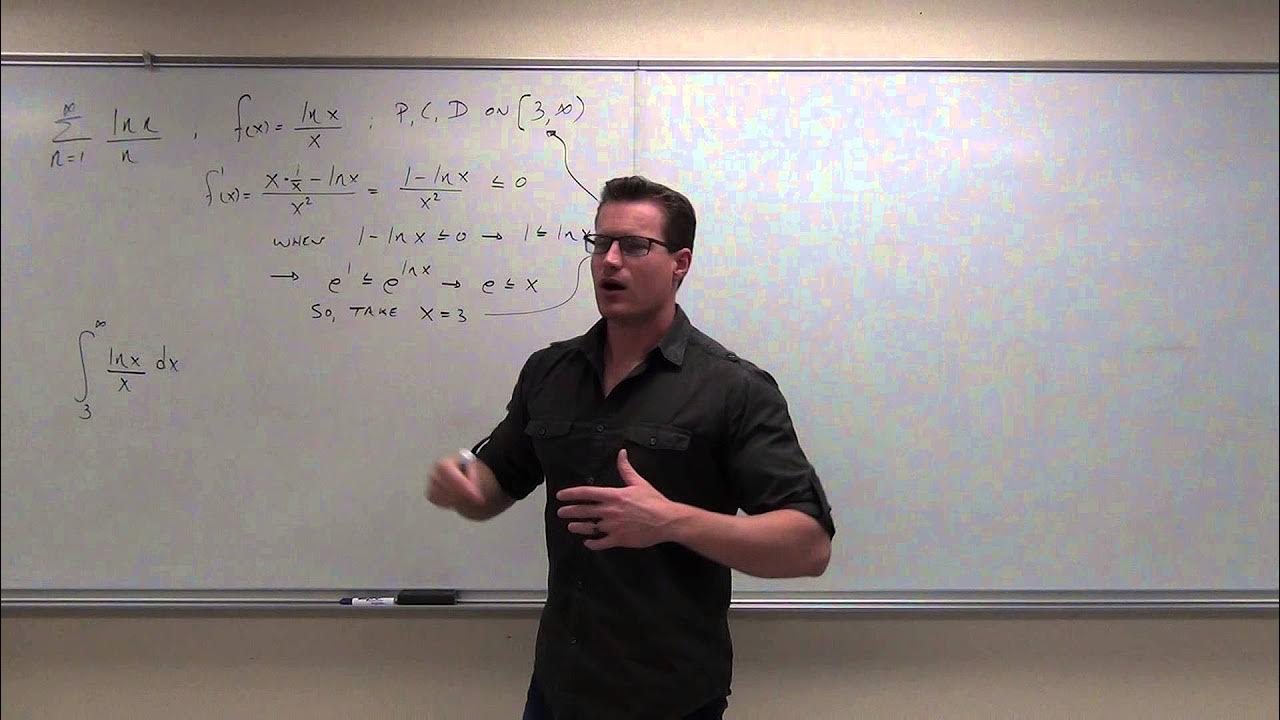Series Tests - The Integral Test
TLDRThis video explains the Integral Test, a method to determine if a series of constants converges or diverges. It outlines the necessary conditions: continuity, positivity, and decreasing nature of the function. An example using the sum of n over n squared plus 1 squared is provided, demonstrating the process of applying the test and concluding the series converges.
Takeaways
- 📚 The Integral Test is a method to determine if a series of constants converges or diverges.
- 🔍 To use the Integral Test, three conditions must be met: the function f(x) must be continuous, positive, and decreasing for values from some point to infinity.
- 📉 The test involves comparing the convergence of the series to the convergence of the improper integral of f(x) from a certain point to infinity.
- 📝 If the integral converges, so does the series, and if the integral diverges, the series does as well.
- 🔑 The function f(x) is often chosen to be similar to the general term of the series, a_n.
- 📈 The function f(x) needs to be decreasing, which may require proving by taking its derivative.
- 📚 The derivative of f(x) can be used to show that the function is decreasing, which is a common step in the Integral Test process.
- 🧩 The Integral Test can be particularly useful if the function f(x) is easy to integrate or if computational tools are available to assist with the integration.
- 🤔 Sometimes, despite its potential complexity, the Integral Test is the only option if other tests are not applicable or if it is specifically required.
- 📉 The test involves setting up and solving an improper integral, which can be a complex process.
- 💡 The video provides an example of applying the Integral Test to a series, demonstrating the steps involved in the process, including proving the decreasing nature of the function and solving the integral.
Q & A
What is the Integral Test used for?
-The Integral Test is used to determine if a series of constants converges or diverges.
What are the three conditions required for the Integral Test to be applicable?
-The three conditions are: 1) the function f(x) must be continuous, 2) f(x) must be positive, and 3) f(x) must be decreasing.
What happens if the integral from K to infinity of f(x) dx converges?
-If the integral converges, then the sum of the series also converges.
What happens if the integral from K to infinity of f(x) dx diverges?
-If the integral diverges, then the sum of the series also diverges.
What is the first step in applying the Integral Test to a series?
-The first step is to define a function f(x) such that f(n) = a_n, where a_n is the nth term of the series.
Why is it necessary to prove that f(x) is decreasing?
-Proving that f(x) is decreasing is necessary to ensure that the Integral Test can be applied, as one of the conditions is that f(x) must be decreasing.
How can you determine if f(x) is decreasing?
-One way to determine if f(x) is decreasing is by taking the derivative of f(x). If the derivative is negative for x ≥ 1, then f(x) is decreasing.
What is an example of a series that could be tested using the Integral Test?
-An example is the series ∑(n/(n^2 + 1)^2) from n=1 to infinity.
What is the advice given for when to use the Integral Test?
-The advice is to use the Integral Test when: 1) it looks like you can form f(x) and it would be easy to integrate, 2) you can use a calculator with a computer algebra system to do the improper integral, and 3) you are told that you have to use it.
Why might someone prefer other tests over the Integral Test?
-Some might prefer other tests because the Integral Test can be a lot of work, especially when proving that f(x) is decreasing, which can be tedious.
Outlines
📚 Introduction to the Integral Test
This paragraph introduces the Integral Test, a mathematical tool used to determine the convergence or divergence of a series of constants. The test is applicable if the function f(x) can be associated with the series' terms, and it requires three conditions: continuity, positivity, and decreasing nature of f(x) from a certain point to infinity. The paragraph explains that if the improper integral of f(x) converges, then so does the series, and vice versa. An example is given where the series is the sum from 1 to infinity of n over (n squared plus 1) squared, and f(x) is defined accordingly. The paragraph details the process of verifying the three conditions and performing the integral to apply the test.
🔍 When to Use the Integral Test
The second paragraph provides guidance on when to use the Integral Test. It suggests using the test when the series can be easily associated with a function that is straightforward to integrate. It also highlights the utility of the test when a computer algebra system is available to perform the improper integral, reducing the manual effort. Additionally, the paragraph mentions that the test might be mandatory in certain scenarios, despite the preference for other tests like the p-series or geometric series tests due to the Integral Test's sometimes cumbersome nature, especially when proving the decreasing nature of the function. The advice includes using the derivative to demonstrate the function's decrease if necessary.
Mindmap
Keywords
💡Integral Test
💡Convergence
💡Diverges
💡Continuous
💡Positive
💡Decreasing
💡Improper Integral
💡Quotient Rule
💡Limit
💡Substitution
💡Fundamental Theorem of Calculus
Highlights
The integral test is a method to determine if a series of constants converges or diverges.
The integral test requires three conditions: continuity, positivity, and decreasing nature of the function f(x).
The function f(x) must be continuous, positive, and decreasing from some value to infinity.
If the improper integral of f(x) from K to infinity converges, then so does the sum of a_n.
If the improper integral of f(x) diverges, then the sum of a_n also diverges.
The integral test is laborious and involves proving the decreasing nature of f(x).
An example is given with the sum of n over (n^2 + 1)^2 from 1 to infinity.
The function f(x) is defined as x over (x^2 + 1)^2 for x greater than or equal to 1.
The positivity of f(x) is straightforward since x is greater than or equal to 1.
The continuity of f(x) is confirmed as there are no discontinuities.
The decreasing nature of f(x) is not obvious and requires proof using the derivative.
The derivative f'(x) is calculated using the quotient rule and simplified.
The integral test is applied after confirming the conditions for f(x).
An improper integral from 1 to infinity of f(x) is set up with proper notation.
The integral is solved using substitution, resulting in a limit as B approaches infinity.
The integral converges to 1/4, indicating that the series also converges by the integral test.
Advice is given on when to use the integral test, such as when f(x) is easy to integrate.
Using a calculator with a computer algebra system can simplify the integral test process.
The integral test is often used when required, despite the potential for other tests to be more convenient.
The integral test involves proving the decreasing nature of f(x) using calculus concepts.
The video concludes with the integral test being a useful tool, despite its complexity.
Transcripts
Browse More Related Video

Worked example: Integral test | Series | AP Calculus BC | Khan Academy

Integral test | Series | AP Calculus BC | Khan Academy

The Root Test

Calculus 2 Lecture 9.3: Using the Integral Test for Convergence/Divergence of Series, P-Series

Convergence and Divergence - Introduction to Series

Conditional and Absolute Convergence for Infinite Series
5.0 / 5 (0 votes)
Thanks for rating: